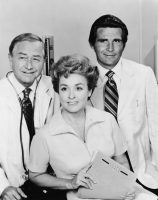TV’s Top Doctors: Over 50 Years Of Good Practice

By Matt Roush, ReMIND Magazine
Where would TV be without its good doctors? Thankfully, for the health of the medium and all who watch, we’ll probably never have to find out. From daytime, where General Hospital has reigned for 56 years, to primetime, currently home of the popular if peculiar The Good Doctor (starring Freddie Highmore as autistic savant surgeon Dr. Shaun Murphy), TV has always flourished under superior medical care.
TV doctors are a rare breed of hero: schooled in the exacting art of preserving life and doing no harm, while in most cases developing an enviable bedside manner. They come in a variety of ages eager interns to avuncular sages — as well as temperaments (was there ever as great a curmudgeon as Hugh Laurie’s brilliant Dr. Gregory House in House?). We take comfort in their authority and expertise as they make weekly house calls in our living rooms.
TV’s Introduction To The Heartthrob Doc The 1960s gave us two distinctive and iconic role models: Richard Chamberlain as an idealistic heartthrob in Dr. Kildare and Vince Edwards as a swarthy neurosurgeon-in-training in Ben Casey. (Both series aired from 1961-66.) I vividly remember when, getting my tonsils out in my first hospital visit as a child of the mid ’60s, I flashed back to Ben Casey’s intense opening credits as the gurney wheeled me under the lights to the operating room. Just like on TV!
Anyone would be lucky to have such dedicated young physicians tending to them. Long before he became “King of the Miniseries” in the 1980s, Chamberlain was a small-screen idol as James Kildare, merchandised to the max and even recording a hit single — “Theme From Dr. Kildare (Three Stars Will Shine Tonight)” — with swoony lyrics set to the show’s melodic theme. In what would become standard operating procedure for the genre, both men benefited from the wisdom of mentors: for Kildare, Raymond Massey as Dr. Leonard Gillespie; for Casey, Sam Jaffe’s Dr. David Zorba.
Welby And M*A*S*H Were The Biggest Hits Of The ’70s This dynamic would carry into the 1970s, although it was the elder-statesman doc who took top billing in the biggest dramatic hit of the time: Marcus Welby, M.D., which brought Father Knows Best’s Robert Young out of retirement to play the unorthodox general practitioner. His humanistic approach to medicine often clashed with the by-the-book methods of his motorcycle-riding sidekick, Dr. Steven Kiley (James Brolin). Viewers ate it up, turning Welby into ABC’s first ever show to hit No. 1 in the ratings, with an average 29.6 million viewers.
Tweaking the funny bone with irreverence and barbed wit was the specialty of the Army doctors on M*A*S*H, which emerged from cult notoriety in the early ’70s to become one of TV’s longest-running and most beloved classics. (The movie-length finale in 1983 attracted a then-record audience of 125 million.)
The 4077th boasted many memorable doctors, none more than Alan Alda’s wisecracking Hawkeye Pierce, a freewheeling smart aleck who was deadly serious about treating soldiers in the Korean conflict and sounding off about the insanity of combat: “War isn’t hell. War is war, and hell is hell. And of the two, war is a lot worse.” Hawkeye’s best pal, “Trapper John” McIntyre (Wayne Rogers), left after three seasons — but was resurrected years later in Trapper John, M.D. with Pernell Roberts assuming the title role as an older version of the doctor, now supervising whippersnappers including Dr. “Gonzo” Gates (Gregory Harrison).
Then The Kid Doctor Came Along … Clearly, playing doctor isn’t kid stuff — unless you’re the teenage prodigy of Doogie Howser, M.D. (1989-93, which put Neil Patrick Harris on the map in an improbably touching coming-of-age comedy-drama. Each episode ended with the kid genius philosophizing on the computer about his learning curve: “Kissed my first girl. Lost my first patient. Life will never be the same again.”
Amid The Nonstop Trauma Were Some Superstars The medical genre grew richer and more realistic in the 1980s with the layered emotional stories of St. Elsewhere, which introduced Denzel Washington and Mark Harmon as Dr. Phillip Chandler and Dr. Robert Caldwell. Acclaimed but a sleeper in the ratings, Elsewhere was eclipsed by the phenomenon of ER in the 1990s, electrifying in its depiction of nonstop trauma.
A superstar was born in George Clooney’s Dr. Doug Ross, with his bedroom eyes and cocky manner. The playboy pediatrician was responsible for the show’s highest-rated episode, Season 2’s “Hell and High Water” in 1995, when Dr. Ross rescued a boy from drowning in a storm drain with 48 million fans rooting him on. They were even more thrilled when, years later, he ended up with his soulmate, nurse Carol Hathaway (Julianna Margulies), in a surprise return.
ER’s 15-season run will soon be overtaken by the soapier Grey’s Anatomy, which coined the term “McDreamy” for its matinee-idol doctor, Derek Shepherd (Patrick Dempsey), while breaking new ground by putting a diverse crew of accomplished female docs center stage, including Ellen Pompeo as his wife, Dr. Meredith Grey; Chandra Wilson as the formidable Dr. Miranda Bailey; and Sandra Oh as Meredith’s “person,” the driven Dr. Cristina Yang.
TV doctors have come a long way, baby, and that should make us all feel good.
Photo Credit: Marcus Welby, M.D.: Credit: ABC Television/Courtesy of Getty Images
Brought to you by the publishers of ReMIND magazine, a monthly magazine filled with over 95 puzzles, retro features, trivia and comics. Get ReMIND magazine at 70% off the cover price, call 1-855-322-8784 or visit remindmagazine.com. ©2018 ReMIND magazine

Examiner Media – Keeping you informed with professionally-reported local news, features, and sports coverage.
